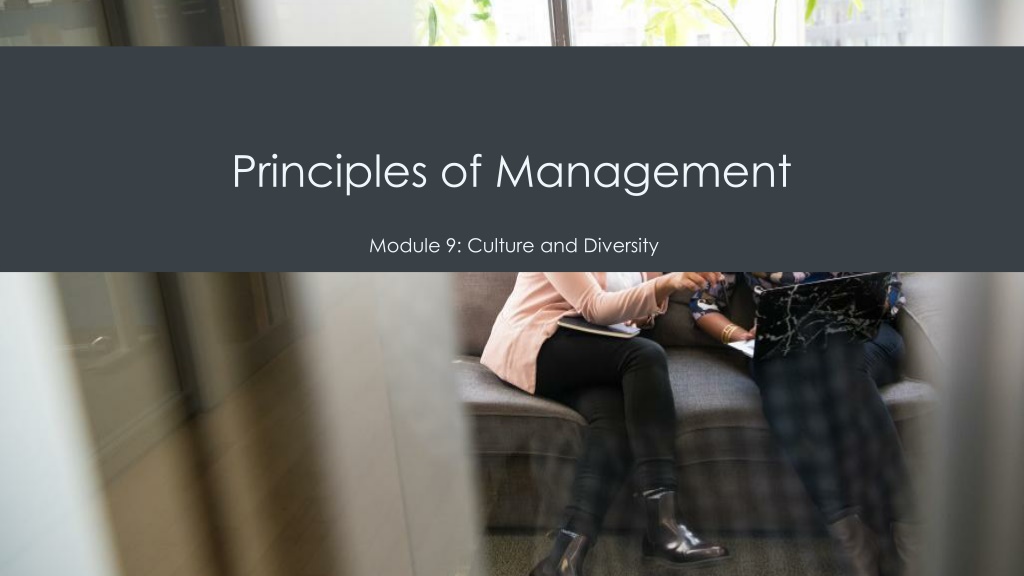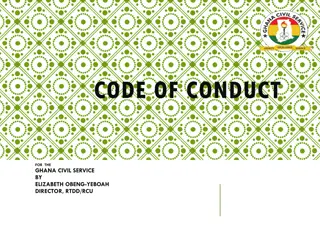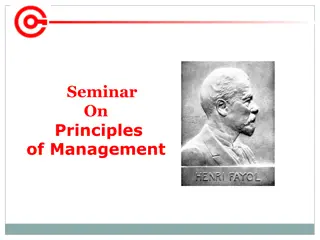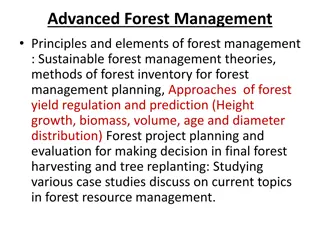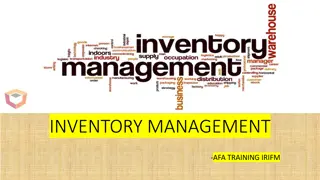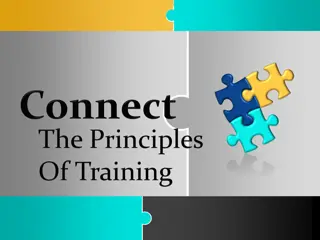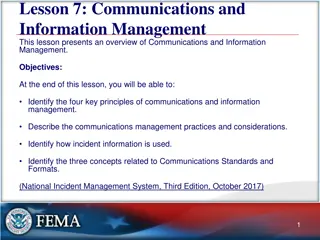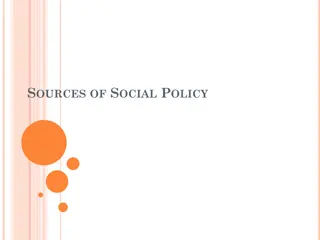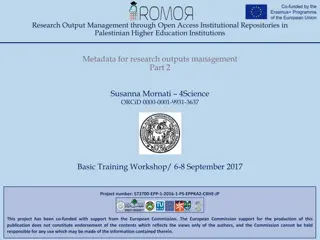Principles of Management
Exploring the significance of organizational culture and diversity in management, this module covers topics such as defining organizational culture, its competitive advantages, key dimensions, influences, techniques for fostering cultural change, and managing employee diversity. Examples from companies like IBM and Google showcase how corporate cultures can shape workplace environments and employee experiences.
Download Presentation

Please find below an Image/Link to download the presentation.
The content on the website is provided AS IS for your information and personal use only. It may not be sold, licensed, or shared on other websites without obtaining consent from the author. Download presentation by click this link. If you encounter any issues during the download, it is possible that the publisher has removed the file from their server.
E N D
Presentation Transcript
Principles of Management Module 9: Culture and Diversity
Module Learning Outcomes Discuss organizational culture and the benefits of diversity. 9.1: Describe organizational culture, and explain how culture can be a competitive advantage 9.2: Identify key dimensions of organizational culture 9.3: Identify the main influences on organizational culture, and explain how culture is maintained 9.4: Describe the key techniques for initiating and fostering cultural change 9.5: Identify the advantages and challenges of employee diversity within organizations
Learning Outcomes: Organizational Culture 9.1: Describe organizational culture, and explain how culture can be a competitive advantage 9.1.1: Define culture for a business 9.1.2: Explain how culture can be a competitive advantage for a business 9.1.3: List the levels of culture
What Is Organizational Culture? Term that can relate to any organization at all, from a church to a university Corporate Culture: shared values, attitudes, standards, and beliefs that characterize members of an organization and define its nature When not intentionally created, can be disjointed or antagonistic Developed from knowledge of national, regional, and family cultures
What Do Corporate Cultures Look Like? IBM Google Apple
IBM Founder Thomas Watson was one of the great developers of corporate culture- encouraged morality, temperance, and consistency. Men were expected to dress in certain style (dark suits, white shirt) and behave conservatively. IBM Spirit was represented in corporate songs that employees were required to sing at conventions.
Google Endless perks for valued employees- coffee bars, free meals, breaks, option to bring pet to work List of core values: We want to work with great people. Technology innovation is our lifeblood. Working at Google is fun. Be actively involved; you are Google. Don t take success for granted. Do the right thing; don t be evil. Earn customer and user loyalty and respect every day. Sustainable long-term growth and profitability are key to our success. Google cares about and supports the communities where we work and live.
Apple More focused on outcomes and excellence Core values: Believing that they re on the face of the Earth to make great products Believing in the simple, not the complex Believing they need to own and control primary technology behind products We participate only in markets where we can make a significant contribution. Believing in saying no to projects to focus on most important ones Believing in deep collaboration and cross-pollination of groups Not settling for anything less than excellence in every group of company and having honesty to admit when they re wrong/willing to change
Corporate Culture as a Competitive Advantage Strong culture helps employees, customers, and general public to identify corporate values Companies with strong, coherent cultures attract high-quality employees who believe in same values as corporation- begin to feel on board and like they belong Strong corporate culture can help corporation to build its brand
Levels of Corporate Culture E.H. Schein- theorist who studies corporate culture- wrote book titled Organizational Culture and Leadership- three levels of corporate culture At core- basic assumptions about human behavior Surrounding core- values drawn from assumptions- standards, rules Surface level- artifacts - outcome of assumptions and values (actions, policies, physical environment, office jokes, etc.
Practice Question 1 What is meant by Assumptions in the levels of corporate cultures? 1. Beliefs regarding basic traits of employees. 2. Beliefs regarding work ethic of employees. 3. Beliefs regarding the honesty of employees. 4. Beliefs regarding appropriate work/life balance of employees.
Learning Outcomes: Key Dimensions of Organizational Culture 9.2: Identify key dimensions of organizational culture 9.2.1: Discuss seven dimensions of culture in the Organizational Culture Profile
Exploring Key Dimensions of Organizational Culture Detail-oriented- meticulous attention to details Ritz Carlton hotels Innovative- individuals who want opportunities to invent new products GORE-TEX or Google Aggressive- value of competition Microsoft Outcome-oriented- all about results Best Buy Stable- knowing who is charge, who to report to, and what to accomplish Kraft Foods People-oriented- expect the company to care about you- value of fairness Starbucks Team-oriented- employees who like to collaborate & cooperate with team Southwest Airlines
Learning Outcomes: Influences on Organizational Culture 9.3: Identify the main influences on organizational culture, and explain how culture is maintained 9.3.1: Discuss the sources of culture in an organization 9.3.2: Explain the methods for maintaining a culture 9.3.3: List the visible signs of culture
Influences on Organizational Culture Sources of Culture Founders Have a vision for their new company which helps form corporate culture Some founders have strong personalities and values that company reflects goals upon Examples: Walt Disney, Ben and Jerry s Ice Cream Industry Industries that are built around regulations and policies that can t be changed and industries that are creative, innovative, and fun
Methods for Maintaining Corporate Culture Recruiting- finding employees who will fit into corporate culture Hiring- assessing candidate s assumptions and values Onboarding- new employee orientation process- teach company policies Training- formal and informal (technology or changes, depending on job)
Practice Question 2 Which of the following are NOT a method for maintaining corporate culture: 1. Onboarding. 2. Hiring. 3. Training. 4. Incenting.
Visible Signs of Culture When you walk into a business setting, you should be able to see visible signs of business s organizational culture Few things to watch out for: How employees dress Snack areas/candy jars Plaques and awards Mission statement Events and rituals Physical layout and d cor
Learning Outcomes: Cultural Change 9.4: Describe the key techniques for initiating and fostering cultural change 9.4.1: Describe key techniques for initiating cultural change (sense of urgency, role modeling, changing leaders) 9.4.2: Describe key techniques for fostering cultural change (training, reward systems, and new stories and symbols)
Initiating and Managing Cultural Change Initiating Create sense of urgency Role modeling Changing leaders Managing Excellent communication Changing leaders who present barriers to change Training programs Changing reward systems and corporate symbols Changing look and feel of the workplace
Class Activity: Initiating and Managing Cultural Change Break into small groups. Review the corporate culture attributes of Google and Apple from slides 7-9. Which of these corporate cultures would you prefer to be a part of? If you were the CEO of a startup, and wanted to develop a corporate culture similar to your choice, what steps would you follow to do so?
Learning Outcomes: Employee Diversity 9.5: Identify the advantages and challenges of employee diversity within organizations 9.5.1: Explain the concept of diversity within organizations 9.5.2: Explain the advantages of employee diversity within organizations 9.5.3: Explain the challenges of employee diversity within organizations
Employee Diversity: What Is It? Diversity is now required by law and is a recommended strategy Long-term strategy- broader meaning which adds personality, cognitive style, education, background, and more Diversity in workplace isn t easy to achieve Explosive growth in global trade means large companies grew in diversity
Advantages and Challenges of Employee Diversity Advantages Builds resilience Permits system to evolve and learn from experience Enhances creativity Enhances image Improves outreach Improves morale Challenges Differences in culture Work styles can vary from culture to culture Management: top leadership technically white and male and lower level is usually female and nonwhite
Quick Review Can you define culture for a business? How can culture be a competitive advantage for a business? What are the levels of culture? Can you effectively discuss the seven dimensions of culture in the Organizational Culture Profile? What are some key techniques for initiating cultural change? For fostering cultural change? What is the concept of diversity within organizations? What are the advantages of employee diversity within organizations? Can you explain the challenges of employee diversity within organizations?
